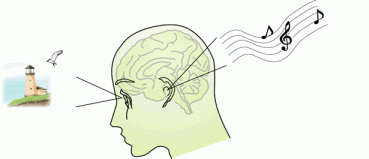Prediction-based Models of Human Auditory System
Animals survive inevitably facing the non-stationary world as well as noises of their sensors and motors. It has been becoming an acceptable viewpoint that their amazing robustness must be supported by theoretically-sound information processing in their brain. Based on this viewpoint, we have been investigating visual and auditory information processing in humans, emphasizing their predictive aspects.

Auditory processing based on the prediction of frequency characteristics of sounds
We usually perceive a single pitch when we strike a key of a piano. But actually the sound that is generated by striking one key of a piano includes several frequency components as shown below figure. A single frequency component hardly occurs alone in natural environment. It is because the sounds have wave characteristics that generate a resonance and not interfere the sounds, which have multiple frequency components of the other one's. Therefore it is reasonable to perceive a single sound even if it has several frequency components as far as they are a multiple of the lowest one. It is supposed that we utilize the physical characteristics of the environment to do an efficient information processing.

We try to account for the physiological and psychological phenomena using the model that predicts the frequency characteristics of sounds.
